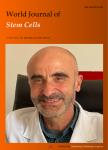Effects of different concentrations of nicotinamide on hematopoietic stem cells cultured in vitro
作者机构:The Second Clinical Medical CollegeShanxi Medical UniversityTaiyuan 030001Shanxi ProvinceChina Department of HematologyThe Second Hospital of Shanxi Medical UniversityTaiyuan 030001Shanxi ProvinceChina Department of HematologyKey Laboratory of Molecular Diagnosis and Treatment of Blood Diseases in Shanxi ProvinceTaiyuan 030001Shanxi ProvinceChina
出 版 物:《World Journal of Stem Cells》 (世界干细胞杂志(英文版)(电子版))
年 卷 期:2024年第16卷第2期
页 面:163-175页
核心收录:
学科分类:0831[工学-生物医学工程(可授工学、理学、医学学位)] 0710[理学-生物学] 1002[医学-临床医学] 100214[医学-肿瘤学] 10[医学]
基 金:the Science and Technology Department of Shanxi Province,No.YDZJSX2021B009 Health Commission of Shanxi Province,No.2021XM07 Shanxi Provincial Department of Education,No.2023KY380.
主 题:Hematopoietic stem cells Nicotinamide Concentration Proliferation Differentiation Sirtuin 1
摘 要:BACKGROUND In vitro expansion to increase numbers of hematopoietic stem cells(HSCs)in cord blood could improve clinical efficacy of this vital resource.Nicotinamide(NAM)can promote HSC expansion ex vivo,but its effect on hematopoietic stem and progenitor cells(HSPCs,CD34^(+)CD38)and functional subtypes of HSCs-shortterm repopulating HSCs(ST-HSCs,CD34^(+)CD38CD45RACD49f^(+))and long-term repopulating HSCs(LT-HSCs,CD34^(+)CD38CD45RACD49f^(+)CD90^(+))is not yet known.As a sirtuin 1(SIRT1)inhibitor,NAM participates in regulating cell adhesion,polarity,migration,proliferation,and differentiation.However,SIRT1 exhibits dual effects by promoting or inhibiting differentiation in different tissues or cells.We propose that the concentration of NAM may influence proliferation,differentiation,and SIRT1 signaling of HSCs.AIM To evaluate the effects and underlying mechanisms of action of different concentrations of NAM on HSC proliferation and differentiation.METHODS CD34^(+)cells were purified from umbilical cord blood using MacsCD34 beads,and cultured for 10-12 d in a serum-free medium supplemented with cytokines,with different concentrations of NAM added according to experimental requirements.Flow cytometry was used to detect phenotype,cell cycle distribution,and apoptosis of the cultured cells.Real-time polymerase chain reaction was used to detect the transcription levels of target genes encoding stemness-related factors,che mokines,components of hypoxia pathways,and antioxidant enzymes.Dichloro-dihydro-fluorescein diacetate probes were used to evaluate intracellular production of reactive oxygen species(ROS).Determination of the effect of different culture conditions on the balance of cytokine by cytometric bead array.RESULTS Compared with the control group,the proportion and expansion folds of HSPCs(CD34^(+)CD38)incubated with 5 mmol/L or 10 mmol/L NAM were significantly increased(all P10 mmol/L,cell viability significantly decreased.In addition,compared with the 5 mmol/L NAM group,the proportion of apoptotic cells in the 10 mmol/L NAM group increased and the proportion of cells in S and G2 phase decreased.Compared with the 5 mmol/L NAM group,the HSCs incubated with 10 mmol/L NAM exhibited significantly inhibited SIRT1 expression,increased intracellular ROS content,and downregulated expression of genes encoding antioxidant enzymes(superoxide dismutase 1,peroxiredoxin 1).CONCLUSION Low concentrations(5 mmol/L)of NAM can better regulate the balance between proliferation and differentiation,thereby promoting expansion of HSCs.These findings allow adjustment of NAM concentrations according to expansion needs.



